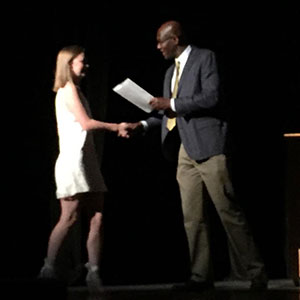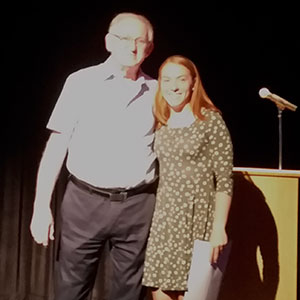![Seven juniors and seniors who participated in the science research summer program pose with a banner from University of Albany. The program is offered through UA.]() Juniors and seniors at Warwick Valley High School have access to a science research program offered through and overseen by the University of Albany.
Juniors and seniors at Warwick Valley High School have access to a science research program offered through and overseen by the University of Albany.
In addition to intermediate and advanced science research courses, enrolled students can earn two college credits over the summer and jump-start their college career with hands-on, collaborative research projects, in consultation with specialized mentors.
This past summer, seven juniors and seniors seized the summer program opportunity to pursue their research interests while exposed to different environments and collaborators.
Students reflect on their summer experience…
“Going for credit over the summer enriched my research experience. I was able to pursue my topic on a deeper level, making my love for it much larger.” —Erin Flannery.
“It was a great to be able to immerse myself in something I’m truly passionate about, and it reinforced my desire to pursue computer science.”—Jack Schenkman
“I really enjoyed working in the university lab, the collaborative environment, and being a part of a scientific research team. I also learned a lot from meeting people from very different cultures and working together around one same objective.” —Jacob Gaydos
Their research topics…
Lauren Lepre, Junior
Mentor: Dr. Gurvinder Singh Sodhi, University of Delhi
Lauren’s research uses the chemical compound basic zinc carbonate, which can be used in a small particle reagent (SPR) suspension. SPR is a technique performed to detect latent fingerprints left on wet and moist surfaces based upon the reaction between fatty acid residuals present in the traces and hydrophobic tails of the specific reagent. Her research involves comparing two dyes that can be used to enhance SPR, crystal violet dye, and eosin b stain. Over the summer, Lauren was able to formulate the first draft of a hypothesis.
Riley Schreibeis, Junior
Mentor: Ms. Rachel Moody, NY Cornell Cooperative Extension
Riley began by studying cattle reproduction, but later changed her topic to cattle nutrition. She started researching different types of supplements, minerals, or vitamins she might possibly test on cattle. Many readily available fruits and vegetables have the minerals and vitamins that cattle need, so they are possible feeding choices. Once she narrows it down to one option, she plans to test the effect of it on the calf’s and the mother’s weight, and their wellbeing after birth.
Erin Flannery, Junior
Mentor: Dr. Emily Waide, Seeing Eye in Morristown, NJ
The goal of the Seeing Eye breeding pool is to generate healthy, intelligent, diverse dogs that demonstrate their breed’s characteristics, and have good temperaments. Erin is researching three genetic diseases present within the Seeing Eye’s breeding pool: cancer, diarrhea, and dermatitis. Over the summer, she learned the statistical computing program (R Statistics) and gained access to the anonymized data tables for the Complete Blood Counts (CBCs) of about 3,000 Seeing Eye Dogs. Erin hopes to analyze these CBCs for correlations between blood levels, breed types, and genetic disease using fixed effects and linear regressions in the statistics program.
Hannah Davis, Junior
Mentor: Dr. Karla V. Ballman, Weill Cornell Medical College
As the winner of the Emperor Science Program, Hannah was able to research HER2+ breast cancer with a renowned biostatician. Her task was to analyze an original dataset made up of women with HER2 breast cancer who were immune to the trastuzumab treatment. Given to her by Dr. Ballman, the dataset provided information on 806 genes, whether the drug trastuzumab was administered or not, and whether or not the cancer was recurring. Hannah’s goal was to identify genes that might be indicative of the patient’s response to trastuzumab.
Lauren Fox, Junior
Mentor: Dr. Christopher Vecsey, Skidmore College
Lauren is studying cell-signaling and neurobiology in Drosophila fruit flies. This summer she had the privilege of working alongside research students who were completing undergraduate research in the laboratory. She was able to narrow her research interests down to optogenetics, a laboratory technique that allows for the control of neural circuits and pathways within the brain, using the manipulation of light-sensitive genes.
Jack Schenkman, Senior
Mentors: Mr. Bryn Dole, IBM, and Officer Calvin Li, NYPD
Jack developed a preprocessing algorithm to improve the compressibility of genomic text files, which are computer files that store DNA sequences. The output of Jack’s algorithm was used to improve the compression performance of an existing compression algorithm. The performance of the existing compression algorithm, with and without the algorithm Jack developed, were compared. Jack is currently evaluating the statistical significance of the results he obtained and exploring potential improvements to the efficiency of his algorithm.
Jacob Gaydos, Senior
Mentor: Dr. Yossi Yovel, Tel Aviv University
Jacob’s research focused on the modulation of echolocation beam characteristic in bats, focusing primarily on beam width. The data for this research was collected during a 10-day, summer trip to Tel Aviv University. During this journey, Jacob worked alongside Dr. Yovel in his lab which studies bat echolocation and the neuroscience behind it. He was able to finish the data collection process and learn the many tools used to analyze sonar data. Jacob will continue analyzing his data and developing his research throughout the school year.
 With a tropical beach for a backdrop, faculty and staff at the Warwick Valley Middle School were treated to an appreciation luncheon on Friday, June 9.
With a tropical beach for a backdrop, faculty and staff at the Warwick Valley Middle School were treated to an appreciation luncheon on Friday, June 9. Sporting floral and nautical prints, guests blended in with seaside-inspired decorations and table centers, and talked about summer plans.
Sporting floral and nautical prints, guests blended in with seaside-inspired decorations and table centers, and talked about summer plans. ![Four PTA volunteers pose for a photo during the middle school PTA's appreciation luncheon for teachers and staff]()
![Three faculty and staff members use plastic bags to collect their loot from the candy bar during the middle school PTA's appreciation luncheon for teachers and staff]() Fratello Italian Restaurant, Warwick
Fratello Italian Restaurant, Warwick![PTA volunteers tend the lunch buffet and guests help themselves during the middle school PTA's appreciation luncheon for teachers and staff]()



 Fratello Italian Restaurant, Warwick
Fratello Italian Restaurant, Warwick








 George Weymer
George Weymer “This is your time!” said WVHS Principal, Dr. Larry Washington, as he welcomed the graduating 8th grade class of 2017 gathered in the High School auditorium for their Awards Assembly on June 22.
“This is your time!” said WVHS Principal, Dr. Larry Washington, as he welcomed the graduating 8th grade class of 2017 gathered in the High School auditorium for their Awards Assembly on June 22.



 The oak tree recently planted in front of the Warwick Valley Middle School was a gift made possible by fifth-grader Sarah Werner, when her artwork won the New York State 2017 Arbor Day
The oak tree recently planted in front of the Warwick Valley Middle School was a gift made possible by fifth-grader Sarah Werner, when her artwork won the New York State 2017 Arbor Day 
 Her fifth-grade class and teacher, Patricia O’Connor, took part in a tree-planting Arbor Day ceremony on June 20. Also present were NYSDEC representatives Sally Kellog and forester George Profous, accompanied by Karen Emmerich with the Warwick Tree Commission.
Her fifth-grade class and teacher, Patricia O’Connor, took part in a tree-planting Arbor Day ceremony on June 20. Also present were NYSDEC representatives Sally Kellog and forester George Profous, accompanied by Karen Emmerich with the Warwick Tree Commission. WVCSD Buildings & Grounds staff prepared the ground and will be providing the extra care needed to help establish the roots of the young oak. With the right conditions, most oak trees can live hundreds of years.
WVCSD Buildings & Grounds staff prepared the ground and will be providing the extra care needed to help establish the roots of the young oak. With the right conditions, most oak trees can live hundreds of years. How to Write an Outstanding College Application Essay:
How to Write an Outstanding College Application Essay: 
 “It’s always nice to be recognized for your hard work,” said Jeffrey Day, one of four Warwick Valley High School seniors recognized as Commended Students by the 2018 National Merit Scholarship Program.
“It’s always nice to be recognized for your hard work,” said Jeffrey Day, one of four Warwick Valley High School seniors recognized as Commended Students by the 2018 National Merit Scholarship Program. 
 Juniors and seniors at Warwick Valley High School have access to a science research program offered through and overseen by the University of Albany.
Juniors and seniors at Warwick Valley High School have access to a science research program offered through and overseen by the University of Albany. What better way to enjoy and connect with a book than to play one of its characters? That was one of the creative ways used by visiting author
What better way to enjoy and connect with a book than to play one of its characters? That was one of the creative ways used by visiting author  Laughter echoed through the middle school media center during Albee’s interactive and exciting presentation. She brought history to life for our young learners by casting them as the historical figures depicted in some of her books. Students, and teachers alike, were captivated by the author’s own story as she shared what inspired her to become a writer and her passion for storytelling.
Laughter echoed through the middle school media center during Albee’s interactive and exciting presentation. She brought history to life for our young learners by casting them as the historical figures depicted in some of her books. Students, and teachers alike, were captivated by the author’s own story as she shared what inspired her to become a writer and her passion for storytelling. Warwick Valley’s Transportation Department has two mascots: Wildcat and Buster!
Warwick Valley’s Transportation Department has two mascots: Wildcat and Buster!

 “I was proud of myself when I took turns with my friends scraping, measuring, mixing, and waiting for the clock,” read Jane’s reflection of her participation in Ms. Melican’s STEM lab today.
“I was proud of myself when I took turns with my friends scraping, measuring, mixing, and waiting for the clock,” read Jane’s reflection of her participation in Ms. Melican’s STEM lab today.
 Students started with a low-quality play dough: gooey, too sticky, wet, messy, crumbly, can’t make a snake—were some of the qualifiers used in the students’ usage tests.
Students started with a low-quality play dough: gooey, too sticky, wet, messy, crumbly, can’t make a snake—were some of the qualifiers used in the students’ usage tests.
 After they completed the design process, students were asked to reflect on what made them proud about their contribution to their engineering team.
After they completed the design process, students were asked to reflect on what made them proud about their contribution to their engineering team.